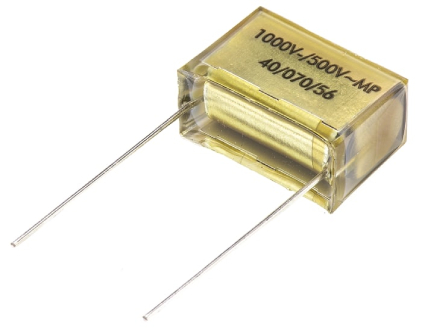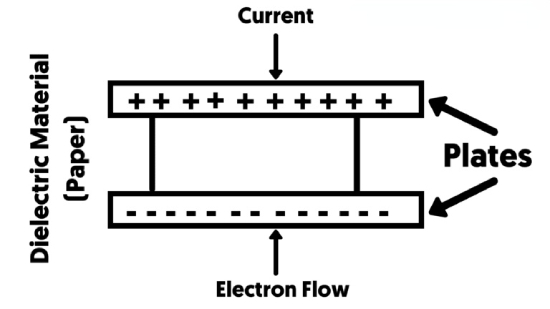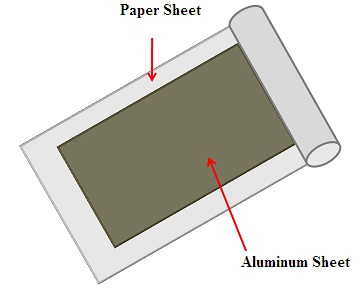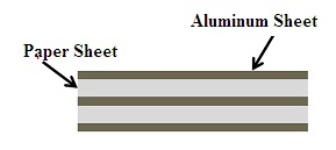Paper capacitors are one of the basic types of capacitors. Typically, in capacitors, conductive materials are separated by a dielectric. Different types of capacitors are formed based on the variant used as a dielectric. The structure of this capacitor is similar to other capacitors, such as plastic capacitors. The only difference between the other capacitors and this one is that the dielectric chosen is paper. Paper capacitors are also known as fixed capacitors, where paper is used as a dielectric, which stores energy in the form of an electric field. Used in capacitance values of 1nF to 1uF at power line frequencies, this capacitor stores a fixed amount of charge. These capacitors tend to store a fixed amount of charge value, so these capacitors are classified as fixed type capacitors. To care for or protect the dielectric from the environment, dip it in wax or oil.

1. Paper capacitance value
The capacitance of a paper capacitor is measured in Faradays. Capacitance of this capacitor ranges from 0.001 to 2.000 microfarads to a high voltage range of 2000V. In the beginning of this capacitor, paper was used as the dielectric between two aluminum sheets but now other materials like plastic are also used instead of paper. The capacitor is readily available in the 300 picofarad to 4 microfarad range and operates at 600 volts.
2. Working principle of paper capacitor
Paper capacitors consist of two metal plates with paper used as the dielectric material between them. There are positive and negative plates, and when a charge is applied to this plate, the positive plate is attracted to one side and the negative charge is attracted to the other plate. This electrical energy is stored in the form of an electric field, and this harvested electrical energy is used by discharging a capacitor. These range from 500pF to 50nF. This creates high leakage currents.

3. Structure of Paper Capacitor
The manufacture of paper capacitors is divided into two types: paper capacitors and metallized paper capacitors.
3.1 Paper capacitor
The construction of this capacitor requires two sheets of aluminum and a sheet of paper that is completely covered in wax to protect it from the open air outside. A paper capacitor is a fixed capacitor that stores a fixed amount of charge with a fixed charge capacitance value, and an aluminum plate of paper is placed between sheets of paper used as a dielectric. Aluminum acts as an electrode. Paper is a very poor conductor of electricity and does not allow current to pass between sheets of aluminum. Allows the electric field to pass through it, acting as a barrier to current flow. Sheets of paper and aluminum are rotated into cylindrical shapes. The entire cylinder is coated with wax or plastic resin to protect it from the humidity of the outside air, and two wires lead from the ends of the two sheets of aluminum.

3.2 Metallized Paper Capacitors
In this paper capacitor, paper is coated with a thin layer of zinc or aluminum and rotated in the form of a cylinder. The entire cylinder is completely waxed to protect it from dust and moisture in the external environment, and the metal paper electrodes and paper act as the dielectric. Such zinc-coated capacitors are easily destroyed due to chemical action, which is why aluminum is widely used to make them. Compared with paper capacitors and metal paper capacitors, metal paper capacitors are smaller in size. This is because it has a very thin layer of aluminum compared to the aluminum wrapped in a paper chip capacitor.

4. Advantages and disadvantages of paper capacitors
The main advantage of using a paper capacitor is that it provides a fixed capacitance value. And the capacitance value can be determined during its production; the main disadvantage of paper capacitors is that they absorb moisture from the atmosphere. And reduce the insulation resistance of the dielectric. Dielectric affects it because it absorbs moisture from the atmosphere.
5. Application of paper capacitor
-
in electrical and electronic circuits.
-
In high voltage and high current applications
-
Used as sensors to measure air humidity, fuel level and mechanical stress.
-
Car audio systems are used to add extra power to amplifiers as needed.
-
Used in electronic noise filtering, signal coupling and decoupling systems, remote sensing.
-
Blocks DC signals and allows AC signals to pass in power conditioning systems.
-
Used in signal processing systems such as speakers, dynamic random access memory (DRAM), tuning circuits, radio receivers, and analog equalizers.
6. Issues related to paper capacitors
6.1 Is paper the dielectric in capacitors?
Paper capacitors are also known as fixed capacitors, where paper acts as a dielectric and stores energy in the form of an electric field .
6.2 Is paper a good dielectric?
Yes, the cellulose fiber matrix of paper has excellent dielectric properties . Paper was a very popular dielectric during the last century. "Paper capacitors" were widely used in early electrical, electronic and radio equipment before the advent of modern, defect-free polymer films.
6.3 What are paper capacitors used for?
Paper capacitors are used in electronic noise filtering, signal coupling and decoupling systems, and remote sensing systems . Used in signal processing systems such as tuners, speakers, dynamic random access memory (DRAM), radio receivers, and analog equalizers, it is useful in screening applications.
6.4 Do paper capacitors have polarity?
Paper capacitors are not polarized . But the body of the capacitor is usually marked with a ribbon at one end. The band indicates the terminal connected to the outermost plate of the capacitor.
6.5 How are paper capacitors made?
The construction of this paper capacitor requires two sheets of aluminum and one piece of paper . Paper acts as a dielectric between the aluminum plates. Aluminum flakes act as electrodes. The paper acts as a barrier to the electrical current between the aluminum plates.
epilogue
The above is the introduction of paper capacitors . If you want to determine the quality of a capacitor, all you need is a wide range digital multimeter and any type of capacitor in your equipment. Connect the multimeter leads to both ends of the capacitor plate. Connect the red test lead of the multimeter to the positive plate of the capacitor and the black test lead to the negative plate. If the meter reading starts at zero and gradually increases to infinity, the capacitor is good. Therefore, a capacitor can be checked with a digital and analog multimeter to determine if it is good, bad, open or shorted.

